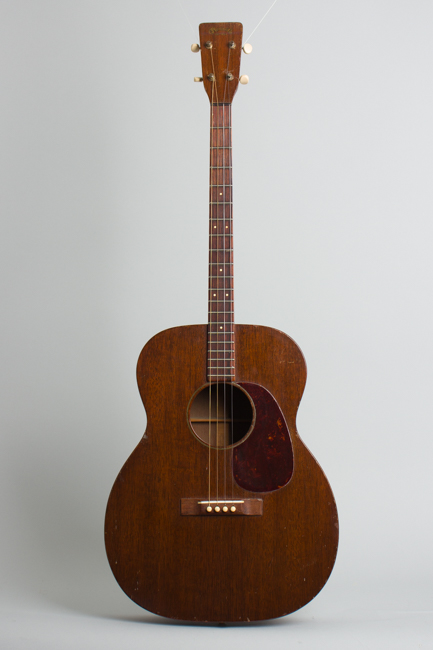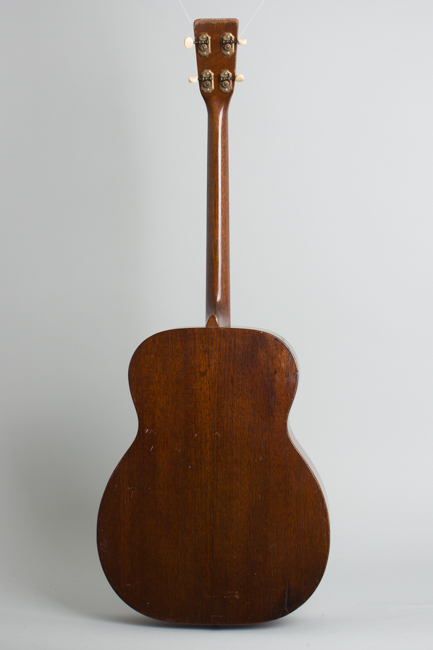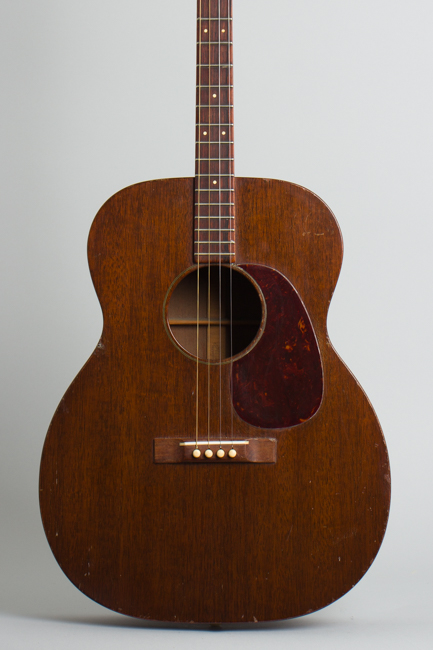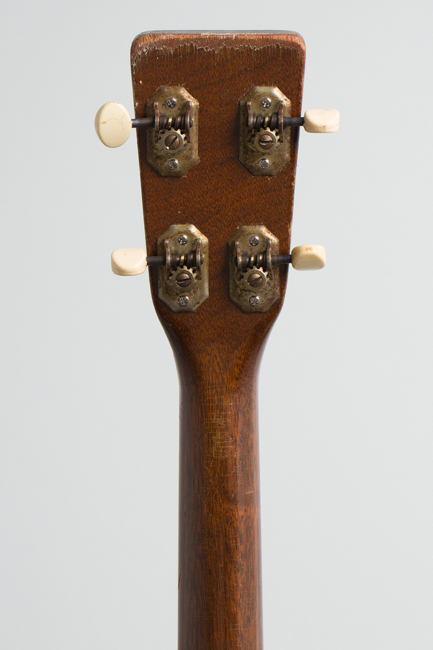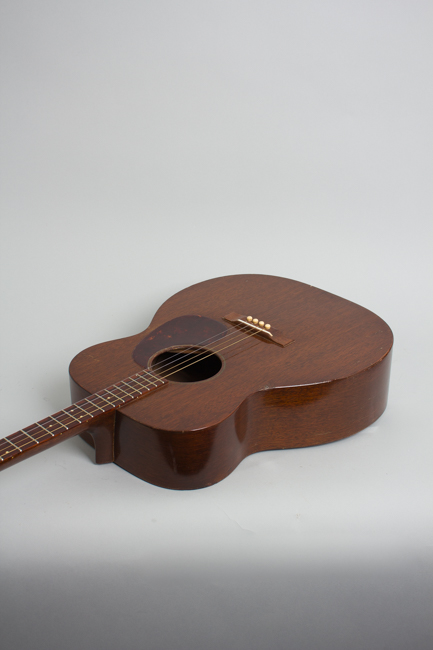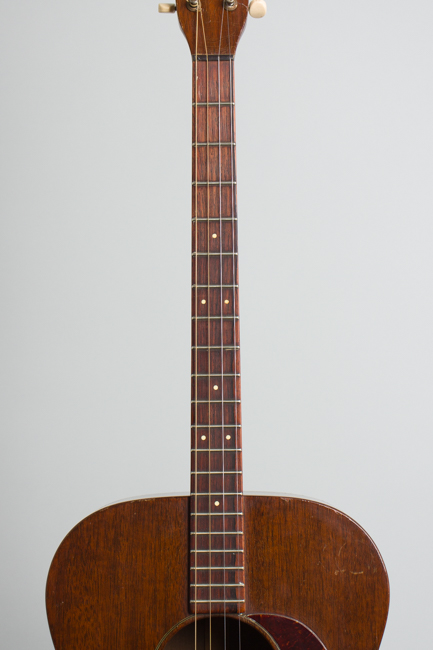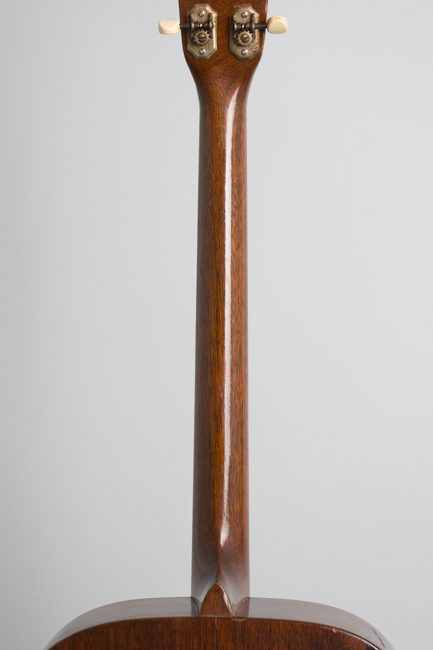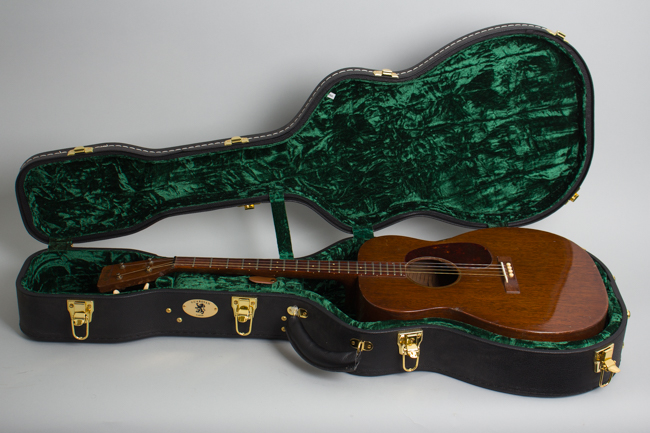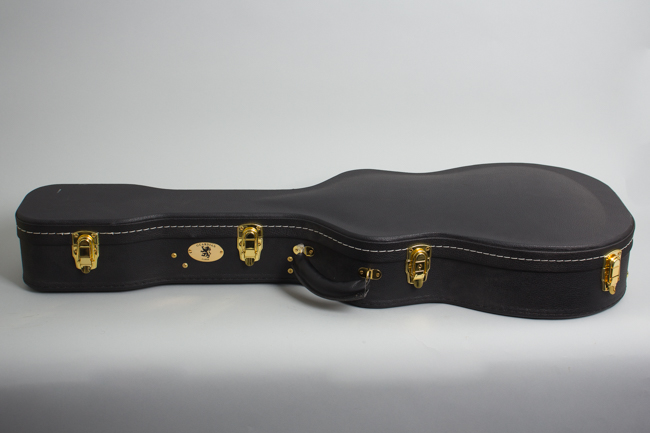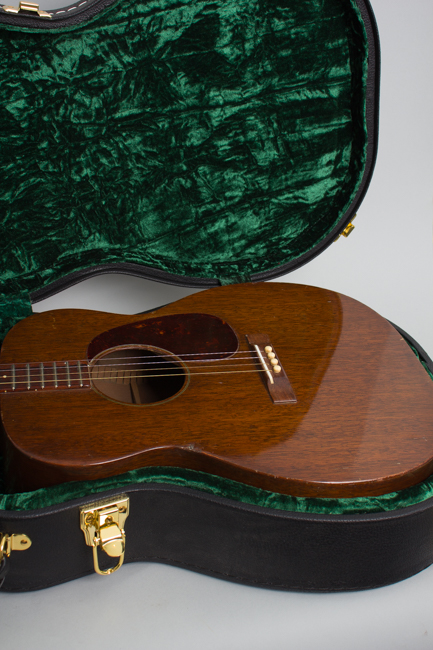C. F. Martin 0-17T Flat Top Tenor Guitar (1953)
C. F. Martin 0-17T Model Flat Top Tenor Guitar (1953), made in Nazareth, PA, serial # 128563, natural lacquer finish, mahogany top, back and neck; rosewood fingerboard, black tolex hard shell case.
The Martin 0-17T is one of the more popular tenor guitars ever made, in production from 1932 right up into the early 1960s. This well-used but fine playing example was made right at the beginning of 1953, some years before Martin's 4-string sales got a boost from the "folk" era influence of the Kingston Trio. Still 150 of these all mahogany tenor guitars were sold that year, the model's peak of production up to that time. Despite being considered somewhat unfashionable by the 1950s tenor guitars continued to be made at Martin after most other manufacturers had given up on them. At $60 list price in early 1953 this would have been about the best quality budget flat-top 4-string in the world.
The 0-17T is a study in careful economy, the standard Martin appointments are reduced to the minimum. There is no trim on the body besides a W/B/W sound hole ring and tortoise celluloid pickguard. The top, back, sides, and neck are all made of mahogany with a rosewood bridge and fingerboard on the 23" scale neck. The Brazilian rosewood-faced headstock has a small "C. F. Martin" decal logo. The tuners are the large-plate openback Klusons seen on many post-WWII guitars.
While designed in the late 1920s for tenor banjoists getting pushed out of work by the preference for the guitar's mellower tone, tenor guitars have a range of possibilities still not fully explored even in the 21st century. Rabon Delmore used small tenor Martin models to play the deftly picked leads that characterize the Delmore Brothers' music, and many others have explored them since. The Martin tenor has always been the best available and even an economy model like the 0-17T has very few peers for 4-string flat-top sonics.
Overall length is 35 1/4 in. (89.5 cm.), 13 5/8 in. (34.6 cm.) wide at lower bout, and 4 1/8 in. (10.5 cm.) in depth at side, taken at the end block. Scale length is 23 in. (584 mm.). Width of nut is 1 3/16 in. (30 mm.).
This is a well-loved and played original Martin, completely solid but showing the results of some past adventures with some visible wear and repair. The finish shows moderate checking overall with dings, dents, and scrapes but less pick wear to the top than many. The back and sides have scattered heavier wear spots, especially along the unbound edges. Some areas have what appears to be old moisture marks. The back of the neck is relatively clean with some small dinks.
There no cracks to the top but the back has visible repairs on the edges with a couple of patched-in spots of mahogany, one at the apex of the upper bass bout and the other off the upper back edge. This lower spot has several sealed cracks emanating from it. The repairs are solid but visible, they are not ongoing structural issues.
The saddle has been lowered but the bridge has never been cut down; the original frets show very little wear. Even the bridgepins and endpin appear original. If a little scruffy looking this is a very good player with a surprisingly powerful sound, complete in a modern hard shell case. Very Good + Condition.
The Martin 0-17T is one of the more popular tenor guitars ever made, in production from 1932 right up into the early 1960s. This well-used but fine playing example was made right at the beginning of 1953, some years before Martin's 4-string sales got a boost from the "folk" era influence of the Kingston Trio. Still 150 of these all mahogany tenor guitars were sold that year, the model's peak of production up to that time. Despite being considered somewhat unfashionable by the 1950s tenor guitars continued to be made at Martin after most other manufacturers had given up on them. At $60 list price in early 1953 this would have been about the best quality budget flat-top 4-string in the world.
The 0-17T is a study in careful economy, the standard Martin appointments are reduced to the minimum. There is no trim on the body besides a W/B/W sound hole ring and tortoise celluloid pickguard. The top, back, sides, and neck are all made of mahogany with a rosewood bridge and fingerboard on the 23" scale neck. The Brazilian rosewood-faced headstock has a small "C. F. Martin" decal logo. The tuners are the large-plate openback Klusons seen on many post-WWII guitars.
While designed in the late 1920s for tenor banjoists getting pushed out of work by the preference for the guitar's mellower tone, tenor guitars have a range of possibilities still not fully explored even in the 21st century. Rabon Delmore used small tenor Martin models to play the deftly picked leads that characterize the Delmore Brothers' music, and many others have explored them since. The Martin tenor has always been the best available and even an economy model like the 0-17T has very few peers for 4-string flat-top sonics.
Overall length is 35 1/4 in. (89.5 cm.), 13 5/8 in. (34.6 cm.) wide at lower bout, and 4 1/8 in. (10.5 cm.) in depth at side, taken at the end block. Scale length is 23 in. (584 mm.). Width of nut is 1 3/16 in. (30 mm.).
This is a well-loved and played original Martin, completely solid but showing the results of some past adventures with some visible wear and repair. The finish shows moderate checking overall with dings, dents, and scrapes but less pick wear to the top than many. The back and sides have scattered heavier wear spots, especially along the unbound edges. Some areas have what appears to be old moisture marks. The back of the neck is relatively clean with some small dinks.
There no cracks to the top but the back has visible repairs on the edges with a couple of patched-in spots of mahogany, one at the apex of the upper bass bout and the other off the upper back edge. This lower spot has several sealed cracks emanating from it. The repairs are solid but visible, they are not ongoing structural issues.
The saddle has been lowered but the bridge has never been cut down; the original frets show very little wear. Even the bridgepins and endpin appear original. If a little scruffy looking this is a very good player with a surprisingly powerful sound, complete in a modern hard shell case. Very Good + Condition.
